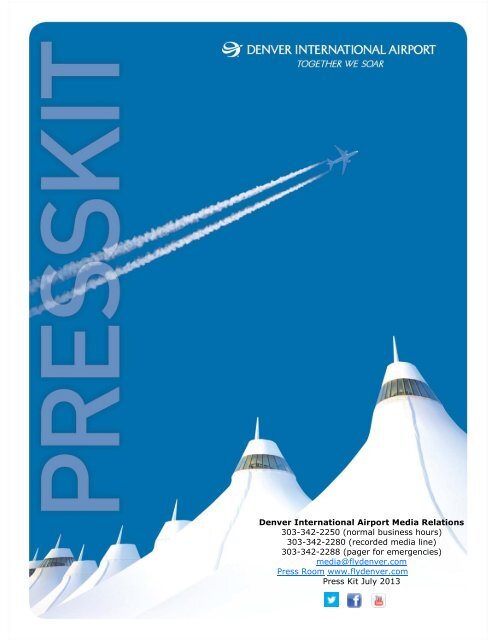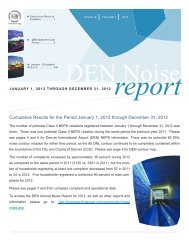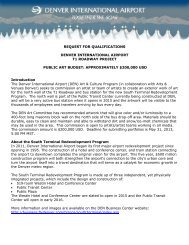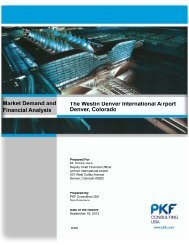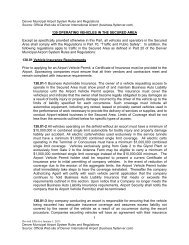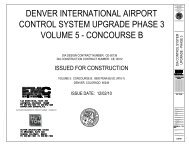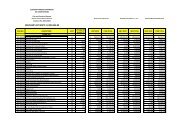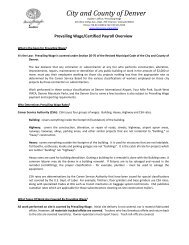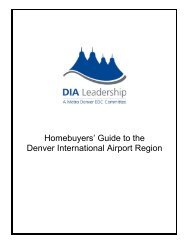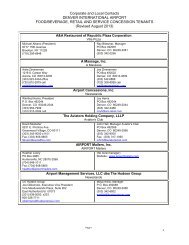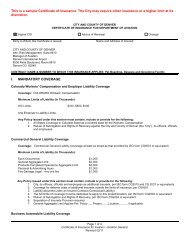Denver International Airport Press Kit - DIA Business Center Home ...
Denver International Airport Press Kit - DIA Business Center Home ...
Denver International Airport Press Kit - DIA Business Center Home ...
Create successful ePaper yourself
Turn your PDF publications into a flip-book with our unique Google optimized e-Paper software.
<strong>Denver</strong> <strong>International</strong> <strong>Airport</strong> Media Relations<br />
303-342-2250 (normal business hours)<br />
303-342-2280 (recorded media line)<br />
303-342-2288 (pager for emergencies)<br />
media@flydenver.com<br />
<strong>Press</strong> Room www.flydenver.com<br />
<strong>Press</strong> <strong>Kit</strong> July 2013
Table of Contents<br />
<strong>Denver</strong> <strong>International</strong> <strong>Airport</strong> At a Glance 3-4<br />
Overview 5<br />
Ownership, Management and Employment 6<br />
<strong>Airport</strong> Ranking by Passengers—U.S. and <strong>International</strong> 7<br />
Passenger Traffic 8<br />
Domestic Origination and Destination (O&D) Passengers 9<br />
Air Service 10<br />
Nonstop Destinations 11<br />
Colorado Destinations 12<br />
Terminal and Gate Areas 13<br />
Runways and Airfield 14<br />
Cargo 15<br />
<strong>Airport</strong> Finance and Revenue Development 16<br />
Non-Airline Revenue 17<br />
Cost per Enplanement 18<br />
Global Environmental Leader 19<br />
Solar Power 20<br />
Public Art 21<br />
Snow Removal 22<br />
Master Plan and Future Growth 23<br />
Future Expansion/Rail Link to Downtown <strong>Denver</strong> 24<br />
South Terminal Redevelopment Program 25<br />
Our Future as an Alliance Hub 26<br />
2
<strong>Denver</strong> <strong>International</strong> <strong>Airport</strong> (DEN) at a Glance<br />
Ownership and Operation<br />
Establishment<br />
Management<br />
City and County of <strong>Denver</strong>, Department of Aviation<br />
City and County of <strong>Denver</strong> Municipal Charter<br />
Department of Aviation enterprise defined by the<br />
Colorado Constitution<br />
The manager of aviation is appointed by <strong>Denver</strong>’s<br />
mayor and serves as a member of the mayor’s cabinet<br />
Total Employees at DEN More than 31,000<br />
Total City and County of More than 1,000<br />
<strong>Denver</strong> Employees at DEN<br />
Opening Date February 28, 1995<br />
Location<br />
Size<br />
Runways<br />
Elrey B. Jeppesen Terminal<br />
24.4 miles (39.9 kilometers) northeast of downtown<br />
<strong>Denver</strong><br />
Latitude: 39 degrees, 50 minutes, 57.8 seconds<br />
Longitude: 104 degrees, 40 minutes, 23.9 seconds<br />
Elevation: 5,431 feet (1,655 meters)<br />
34,000 acres (53 square miles/137.8 square<br />
kilometers)<br />
Six runways: five 12,000 feet in length (3,600 meters);<br />
one 16,000 feet in length (4,800 meters)<br />
12 runways at complete build-out<br />
1.5 million square feet – (139,355 square meters)<br />
Passenger Facilities Ticketing – Level 6<br />
Baggage Claim – Level 5<br />
Passenger Drop-off – Level 6<br />
Passenger Pick-up – Level 4<br />
Ground Transportation – Level 5 (construction)<br />
<strong>International</strong> Arrivals – Level 5 north<br />
Security Screening: three locations in the terminal<br />
Parking more than 40,000 spaces<br />
Automated “people mover” underground train serving<br />
the terminal and gate areas<br />
3
<strong>Denver</strong> <strong>International</strong> <strong>Airport</strong> (DEN) at a Glance<br />
Gate Areas<br />
Gates<br />
Three airside gate areas – A, B, and C<br />
A Gates<br />
1,900 feet (579 meters) long,<br />
1,220,000 square feet (113,342 square meters)<br />
B Gates<br />
3,300 feet (1,006 meters) long,<br />
2,033,872 square feet (188,953 square meters)<br />
C Gates<br />
1,500 feet (457 meters) long,<br />
750,000 square feet (69,677 square meters)<br />
95 with loading bridges; 62 regional aircraft positions<br />
Annual Passenger Capacity 53.2 million in 2012<br />
Airlines<br />
16 commercial airlines, not including charter and<br />
regional carriers, offer nonstop service to more than<br />
180 destinations worldwide (more details on p. 11).<br />
Average Daily Passengers 145,235 (2012)<br />
55 percent originate in <strong>Denver</strong>, 45 percent connect<br />
through <strong>Denver</strong><br />
Average Daily Flights 1,625 (2012)<br />
Average Daily Cargo 647 metric tons per day (2012)<br />
Annual Economic Impact<br />
<strong>Denver</strong> <strong>International</strong> <strong>Airport</strong> is the primary economic<br />
engine for the state of Colorado and generates<br />
US$22.3 billion in economic impact (Colorado<br />
Department of Transportation, 2008)<br />
4
Overview<br />
Since opening on Feb. 28, 1995, <strong>Denver</strong> <strong>International</strong> <strong>Airport</strong> (DEN) has become the<br />
world’s 13 th -busiest airport and the fifth-busiest airport in the United States. With more<br />
than 53 million passengers in 2012, DEN is one of the busiest hubs in the world’s largest<br />
aviation market, the United States, and is Colorado’s primary economic engine, generating<br />
more than $22 billion in annual economic impact for the state<br />
(Colorado Department of Transportation, 2008).<br />
Room to Grow<br />
DEN is one of the few major U.S. airports with room to<br />
expand its current facilities to accommodate future growth.<br />
Encompassing 53 square miles (137.8 square kilometers) of<br />
land, DEN is twice the size of Manhattan Island, and is<br />
larger than the city boundaries of Boston, Miami, or San<br />
Francisco. DEN is the largest airport site in North America<br />
and the second-largest in the world. The efficient layout of<br />
six non-intersecting runways allows for multiple simultaneous<br />
aircraft movements.<br />
DEN has capacity for six additional runways, another<br />
terminal, and two additional concourses. <strong>Denver</strong>’s Runway<br />
16R/34L, which runs north-south and is 16,000 feet long, is<br />
the longest commercial runway in the United States. It is<br />
one of the reasons DEN has received ICAO (<strong>International</strong><br />
Civil Aviation Organization) certification to handle Airbus<br />
380 operations.<br />
Jeppesen Terminal<br />
Ownership<br />
The airport is owned by the City and County of <strong>Denver</strong> and is operated by the <strong>Denver</strong><br />
Department of Aviation. The $4.9 billion city investment in the design and construction of<br />
DEN was financed by a combination of airport bonds, federal aviation grants, and monies<br />
generated by <strong>Denver</strong>’s former airport, Stapleton <strong>International</strong>. Through early and steadfast<br />
planning, DEN has gained significant recognition for financial stability, and has been<br />
profitable every year since opening.<br />
Jeppesen Terminal and the Rocky Mountains<br />
Architecture<br />
DEN’s award-winning architecture and<br />
magnificent views of the Rocky<br />
Mountains create a unique<br />
atmosphere for travelers. Jeppesen<br />
Terminal’s internationally recognized<br />
peaked roof, designed by Fentress<br />
Bradburn Architects, is reflective of<br />
snow-capped mountains and evokes<br />
the early history of Colorado when<br />
Native American teepees were located<br />
across the Great Plains.<br />
Video<br />
5
Ownership, Management, and Employment<br />
<strong>Denver</strong> <strong>International</strong> <strong>Airport</strong>, which is operated by <strong>Denver</strong>’s Department of Aviation, is<br />
established and governed by the City and County of <strong>Denver</strong> Municipal Charter. The<br />
Department of Aviation is an enterprise as defined by the Colorado Constitution. As an<br />
enterprise, DEN does not use any taxpayer dollars for its operation.<br />
<strong>Denver</strong>’s mayor appoints the manager of aviation, who then serves as a member of the<br />
mayor’s cabinet and reports directly to the mayor. The <strong>Denver</strong> City Council, while having<br />
no authority over appointing the manager, has oversight of contracts and purchasing as<br />
prescribed by city rules. Currently, approximately 1,000 people are employed by the<br />
<strong>Denver</strong> Department of Aviation.<br />
Employment opportunities<br />
City and County of <strong>Denver</strong><br />
Department of Aviation Organizational Chart<br />
6<br />
6
<strong>Airport</strong> Ranking by Passengers<br />
U.S. and <strong>International</strong> Rankings<br />
Serving more than 50 million passengers each year for the previous five consecutive years,<br />
<strong>Denver</strong> <strong>International</strong> <strong>Airport</strong> ranks as the fifth-busiest airport in the United States and the<br />
13th-busiest airport in the world. The airport rankings by passenger traffic (enplanements<br />
and deplanements) are included below.<br />
7
Passengers<br />
Passenger Traffic<br />
Today, 55 percent of travelers at DEN are origination and destination (O&D)<br />
passengers, and 45 percent are connecting. O&D passengers are those beginning or<br />
ending their trip in <strong>Denver</strong>. More than 28 million annual domestic passengers begin or end<br />
their trip in <strong>Denver</strong>, making <strong>Denver</strong> the fifth largest domestic O&D hub in the U.S.<br />
<strong>International</strong> traffic at DEN accounts for approximately 1.7 million passengers annually –<br />
approximately 3 percent of the airport’s total passenger traffic.<br />
DEN Passengers (2012)<br />
O&D, 55%<br />
Connecting, 45%<br />
<strong>Denver</strong> <strong>International</strong> <strong>Airport</strong> Annual Passenger Traffic<br />
1995-2012<br />
Total Passengers<br />
53,156,278<br />
50,000,000<br />
40,000,000<br />
30,000,000<br />
8
Domestic Origination and Destination (O&D) Passengers<br />
Origination and destination (O&D) passengers are those that begin or end their trip in a<br />
designated city, and they represent the true demand for air service from a community. As<br />
the chart below demonstrates, DEN has strong competitive airline service in its top 20<br />
domestic O&D markets. Southwest’s entry into the <strong>Denver</strong> market provided a dramatic<br />
boost to domestic O&D traffic at DEN. While metro <strong>Denver</strong> ranks as the 18 th -largest<br />
market in the U.S. in terms of population, DEN ranks as the fifth largest domestic O&D<br />
airport in the U.S.<br />
O&D<br />
Annual<br />
Market Code<br />
Rank Passengers<br />
DEN’s Top Domestic Destinations<br />
CY 2012<br />
Passengers<br />
Daily Each<br />
Way<br />
(PDEW)<br />
Average Fare<br />
(one way)<br />
LCC<br />
Service<br />
Legacy<br />
Service<br />
1 Los Angeles LAX 1,708,139 2,334 $130 F9 WN AA UA US<br />
2 New York NYC 1,211,944 1,656 $172 B6 F9 WN DL UA<br />
3 Chicago CHI 1,149,894 1,571 $133 F9 NK WN AA UA<br />
4 Washington, D.C. WAS 1,053,499 1,439 $215 F9 WN UA<br />
5 San Francisco SFO 976,451 1,334 $149 F9 WN UA<br />
6 Phoenix PHX 975,305 1,332 $110 F9 WN UA US<br />
7 Las Vegas LAS 935,059 1,277 $101 F9 NK WN UA<br />
8 Dallas DAL 861,228 1,177 $126 F9 NK WN AA UA<br />
9 Houston HOU 742,093 1,014 $166 F9 WN UA<br />
10 Minneapolis MSP 698,283 954 $116 F9 WN DL UA<br />
11 Seattle SEA 663,047 906 $140 F9 WN AS UA<br />
12 Atlanta ATL 618,425 845 $138 F9 WN DL UA<br />
13 San Diego SAN 589,255 805 $128 F9 WN UA<br />
14 Boston BOS 544,189 743 $182 B6 WN UA<br />
15 Salt Lake City SLC 513,147 701 $96 F9 WN DL UA<br />
16 Orlando ORL 507,471 693 $164 F9 WN UA<br />
17 Kansas City MCI 447,448 611 $103 F9 WN UA<br />
18 Portland PDX 424,348 580 $138 F9 WN UA<br />
19 Philadelphia PHL 407,035 556 $178 F9 WN UA US<br />
20 St. Louis STL 373,390 510 $126 F9 WN UA<br />
9
Air Service<br />
Sixteen airlines provide approximately 1,625 daily scheduled commercial flights to more<br />
than 180 nonstop destinations from <strong>Denver</strong>. DEN is United Airline’s fourth largest hub by<br />
capacity, is the home base and hub for Frontier Airlines and is also an important airport in<br />
the Southwest Airlines route network. <strong>Denver</strong> ranks as Southwest Airline’s fastest-growing<br />
and sixth largest station in the carrier’s history.<br />
10
Nonstop Destinations<br />
Passengers can reach more than 180 destinations nonstop from <strong>Denver</strong>. Due to <strong>Denver</strong>’s<br />
strength as a domestic hub, the majority of these destinations are in the United States.<br />
<strong>Denver</strong> has nonstop service to 23 international destinations in nine countries – Germany,<br />
Iceland, the United Kingdom, Canada, Mexico, the Dominican Republic, Costa Rica,<br />
Jamaica and Japan. (July 2013)<br />
11
Colorado Destinations<br />
Located near the geographic center of the United States, <strong>Denver</strong> <strong>International</strong> <strong>Airport</strong> is<br />
the only major hub airport within a 500-mile radius. As such, DEN serves as the gateway<br />
into Colorado and the Rocky Mountain West and has direct flights to 12 destinations in<br />
Colorado, including popular ski resorts, vacation and business destinations.<br />
From its sweeping short-grass prairies and red-cliff mesas to its magnificent Rocky<br />
Mountain alpine meadows, Colorado has a wide variety of landscapes to explore. The state<br />
enjoys an average of 300 days of sunshine a year. The Centennial State boasts 10<br />
national parks and monuments, 13 national forests and grasslands, and 42 state parks for<br />
outdoor enthusiasts. Colorado’s 26 premiere skiing areas offer everything for winter sports<br />
buffs. For travelers seeking a more cosmopolitan experience, Colorado offers many<br />
vibrant cities, towns, and resorts that offer exceptional cuisine, cutting-edge art, super<br />
shopping, and exciting nightlife. More information can be found on www.denver.org.<br />
12
<strong>Denver</strong> <strong>International</strong> <strong>Airport</strong>’s signature<br />
roof houses the Jeppesen Terminal<br />
(right), and passengers catch flights at<br />
A, B, and C Gates. To reach A Gates,<br />
passengers can choose to walk over a<br />
pedestrian bridge or take the passenger<br />
train. Access to B and C Gates is limited<br />
to the passenger train. The train<br />
currently operates with 99.99 percent<br />
reliability.<br />
Terminal and Gate Areas<br />
13
Runways and Airfield<br />
DEN currently has six runways – five measure 12,000 feet in length, and the sixth<br />
measures 16,000 feet – nearly three miles long. The 16,000-foot runway (photo below;<br />
16R/34L) is the longest commercial runway in North America. Because of <strong>Denver</strong>’s high<br />
elevation and summer heat, this extra length often is needed for departures.<br />
With 53 square miles (137.8 square kilometers) of land, DEN is one of the few major U.S.<br />
airports with room to expand its current facilities to accommodate future growth. DEN has<br />
capacity for six additional runways, for a total of 12.<br />
14
Cargo<br />
<strong>Denver</strong> <strong>International</strong> <strong>Airport</strong> is the only major hub airport within a 500-mile radius. As<br />
such, DEN serves as the gateway into Colorado and the Rocky Mountain West.<br />
DEN is a world leader when it comes to the ability to<br />
move and handle large volumes of air cargo, making<br />
the airport a perfect place to locate companies that<br />
require steady and reliable shipments of materials and<br />
components from overseas. The airport’s total cargo<br />
operations currently exceed approximately 236,000<br />
metric tons per year. DEN is home to several worldclass<br />
cargo movers and support facilities, including<br />
World Port Cargo Support, DHL, UPS, FedEx and United<br />
Airlines cargo. The airport also has a joint-use cargo<br />
facility that currently serves nine airline operations.<br />
The U.S. Postal Service facility is also located nearby,<br />
providing a wide array of competitive shipping and<br />
receiving options. The layout of the airfield and a 39-acre cargo ramp make freight<br />
handling especially efficient at DEN. And there are no operation curfews, making DEN a<br />
24-hour operation.<br />
Although DEN’s passenger volume has significantly increased over the past several years,<br />
cargo shipments have not experienced similar growth. Market dynamics have changed<br />
significantly, and in many cases, price sensitivity has increasingly trumped time sensitivity.<br />
Estimates indicate that over 50 percent of the region’s air cargo is trucked to Chicago,<br />
Dallas, and West Coast airports.<br />
15
Thousands US$<br />
<strong>Airport</strong> Finance and Revenue Development<br />
In 2012, approximately 54 percent of DEN’s gross revenues came from the rentals, fees,<br />
and charges received from the airlines (airline revenue) operating at DEN under airport use<br />
and lease agreements or other agreements with the city (including landing fees).<br />
<strong>Denver</strong> <strong>International</strong> <strong>Airport</strong> Operations Revenues<br />
As a percent of total operating revenues, 2010-2012<br />
45%<br />
40%<br />
35%<br />
30%<br />
25%<br />
20%<br />
2010<br />
2011<br />
2012<br />
15%<br />
10%<br />
5%<br />
0%<br />
Facility Rentals Concession Parking Revenues Car Rental Landing Fees Aviation Fuel Tax Other Sales and<br />
Source: <strong>Denver</strong> <strong>International</strong> Revenues <strong>Airport</strong> 2011 Revenues Financial Report<br />
Charges<br />
<strong>Denver</strong> <strong>International</strong> <strong>Airport</strong> Operations Revenues (2010-2012)<br />
250,000<br />
200,000<br />
150,000<br />
100,000<br />
2010<br />
2011<br />
2012<br />
50,000<br />
-<br />
Facility Rentals<br />
Concession<br />
Revenues<br />
Parking<br />
Revenues<br />
Car Rental<br />
Revenues<br />
Landing Fees<br />
Aviation Fuel<br />
Tax<br />
Other Sales<br />
and Charges<br />
Source: <strong>Denver</strong> <strong>International</strong> <strong>Airport</strong> 2012 Financial Report<br />
16
Non-Airline Revenue<br />
DEN is focused on increasing its non-airline revenue to<br />
help offset the airlines’ cost of operating so the airport<br />
can remain globally competitive. A wealth of land has<br />
given the airport opportunities to produce revenue in<br />
somewhat novel ways. For example, DEN receives<br />
royalties from oil and gas well production on airport<br />
property. DEN has 76 wells. In 2012, approximately<br />
$6.2 million was generated.<br />
70%<br />
Non-Airline Revenue By Source<br />
Revenue from non-airline sources accounted for approximately 46 percent of operating<br />
revenue at the airport. In 2012, DEN’s non-airline revenue included:<br />
parking ($137.9 million), car rentals ($47.2 million), and concessions ($49.6 million).<br />
Parking<br />
DEN has more than 40,000 city-operated parking spaces. In addition to terminal parking<br />
(garage and shuttle lots), DEN has two remote shuttle lots.<br />
Shopping and Dining<br />
DEN’s shopping and dining program consists of more than 170,000 square feet inside the<br />
airport, including more than 140 locations offering an exciting culinary, fashion and retail<br />
experience. In 2012, the shopping and dining program generated $281 million in gross<br />
sales and more than $49 million in revenue to the airport. DEN’s 38 Retail Merchandising<br />
Units (RMU’s) and kiosks throughout the airport is one of the largest programs in the<br />
airport industry, contributing $12 million in annual gross sales. Over the next several<br />
years, more than 75 percent of DEN’s shopping and dining locations will transform due to<br />
expiring leases. Many new businesses will have the opportunity to compete for space at<br />
<strong>Denver</strong> <strong>International</strong> <strong>Airport</strong> Sources of Revenue (2010-2012)<br />
the airport, and travelers<br />
will benefit from worldclass,<br />
fresh new<br />
products and services.<br />
60%<br />
50%<br />
40%<br />
30%<br />
20%<br />
10%<br />
0%<br />
2010 2011 2012<br />
Airline<br />
Non-Airline<br />
Ground<br />
Transportation<br />
and Rental Cars<br />
DEN charges all<br />
commercial ground<br />
transportation vehicle<br />
operators fees on the<br />
basis of the frequency<br />
and duration of using<br />
the terminal roadways<br />
and curbsides. The city<br />
has concession agreements<br />
with 12 rental car<br />
companies at DEN.<br />
17<br />
Source: <strong>Denver</strong> <strong>International</strong> <strong>Airport</strong> 2012 Financial Report
Cost per enplanement is a term used to<br />
measure an airline’s average cost to<br />
process one departing passenger<br />
through an airport. The chart below<br />
shows DEN’s cost per enplanement<br />
since the airport opened. As a result of<br />
the Sept. 11, 2001, attacks and<br />
subsequent decline in flights and<br />
passengers, cost per enplanement at<br />
DEN increased in 2001.<br />
However, costs since 2002 have shown<br />
a declining trend due to positive factors<br />
such as increased passenger traffic, flat<br />
debt service payments, and proactive<br />
efforts to contain operating and maintenance<br />
expense prescribed budgets.<br />
Cost per Enplanement<br />
Economic factors in 2008-2009, operating costs, and capital improvement costs may have<br />
contributed to the recent increase in cost per enplanement.<br />
The airport’s goal is to remain competitive by keeping costs low.<br />
18
Global Environmental Leader<br />
In 2004, DEN was the first airport in the United States to design and implement an<br />
Environmental Management System encompassing the entire airport that was successfully<br />
certified to meet the requirements of the EMS international standard known as ISO 14001.<br />
The EMS includes detailed environmental procedures and policies that guide all of the<br />
activities conducted on DEN’s 53-square-mile facility. To maintain ISO 14001 certification,<br />
the EMS must also include continual improvement goals. DEN’s EMS includes specific<br />
objectives that go beyond environmental compliance in the areas of waste minimization,<br />
pollution prevention, and energy efficiency. Each year, the airport develops programs and<br />
plans to achieve these aggressive targets. The EMS is audited by a third party every six<br />
months for its conformance to the international standard. A full audit of the entire system<br />
is conducted every three years.<br />
DEN’s environmental management has established many firsts in the United States and<br />
internationally:<br />
First airport in the United States to be accepted into the EPA’s National<br />
Environmental Performance Track Program (2006)<br />
Received FAA Environmental Stewardship Award (2007)<br />
Accepted into Colorado’s environmental leadership program as a Gold level member<br />
(2004)<br />
Active participation in local and state sustainability initiatives including Greenprint<br />
<strong>Denver</strong> and Colorado Action Climate Plan<br />
DEN currently recycles or reuses 21 different types of materials, including<br />
approximately 68 percent of collected aircraft deicing fluids. (2012)<br />
Air Water Waste Energy<br />
- Alternatively fueled,<br />
hybrid, and electric<br />
vehicles in the airport<br />
fleet (DEN maintains 322<br />
alternatively fueled<br />
vehicles, including 211<br />
buses, sweepers, and<br />
other vehicles using compressed<br />
natural gas, 112<br />
electric and hybrid<br />
electric vehicles. Alternative<br />
vehicles make up 32<br />
percent of the airport’s<br />
fleet. (2012)<br />
Green Fleet Video<br />
- Reduced access fees<br />
charged for hybrid taxis<br />
and vans<br />
- A greenhouse gas<br />
emissions inventory for<br />
DEN in 2010<br />
- Employee carpool and<br />
bus pass programs<br />
- “No-Idling” signs and<br />
education program<br />
- Maintaining an aircraft<br />
deicing fluid applied-tocollected<br />
ratio of at least<br />
69 percent (among the<br />
best in the world)<br />
- Low-flush toilets and<br />
waterless urinals<br />
- Stormwater and erosion<br />
management programs<br />
- Composting food and<br />
other organic wastes<br />
- Recycling or reusing<br />
more than 20<br />
different types of<br />
materials. 250<br />
recycling containers in<br />
the public areas<br />
- Three solar power<br />
installations with a<br />
combined power output<br />
of 8 MW<br />
- Fleet vehicle retrofits<br />
and replacements provide<br />
energy savings<br />
- EcoStart motor<br />
controllers installed on<br />
escalators and moving<br />
walkways, which reduce<br />
the power draw of<br />
the motors 24 hours a<br />
day (total savings of<br />
about 1.7 million kWh per<br />
year)<br />
Video<br />
Environmental<br />
Management<br />
information<br />
19
Solar Power<br />
<strong>Denver</strong> <strong>International</strong> <strong>Airport</strong> leads the way in terms of land utilization for solar photovoltaic<br />
energy following the opening of three different farms across the airport site. <strong>Denver</strong>’s<br />
solar project is in fact one of the largest solar installations in North America.<br />
Solar I<br />
In mid 2008, <strong>Denver</strong> <strong>International</strong> <strong>Airport</strong> inaugurated a $13 million solar farm situated on<br />
7.5 acres directly south of Jeppesen Terminal between Peña Boulevard’s inbound and outbound<br />
lanes. The solar farm consists of<br />
more than 9,200 solar panels that follow<br />
the sun to maximize efficient energy<br />
production and generate more than 3.4<br />
million kilowatt hours of electricity per<br />
year. Owned and run by a specialist<br />
independent energy company, Fotowatio<br />
Renewable Ventures, its annual output<br />
amounts to around 50 percent of the<br />
electricity required to operate the train<br />
system that runs between the airport’s<br />
terminal and gate areas. By using this<br />
solar-generated power, DEN will reduce<br />
its carbon emissions as much as five<br />
million pounds each year.<br />
Solar II<br />
In December 2009, a $7 million, 1.6-megawatt solar project on approximately nine acres<br />
north of the airport’s airfield went into operation. The array is a project that involves MP2<br />
Capital and Oak Leaf Energy Partners generating over 2.7 million kilowatt-hours of clean<br />
energy annually and provides<br />
approximately 100 percent of the airport’s fuel farm’s electricity consumption.<br />
Solar III<br />
A third solar installation situated on 28 acres, dedicated in July 2011, is a 4.4MW complex,<br />
expected to generate 6.9 million kilowatt-hours of energy. The gateway will boast three<br />
solar farms spread across a total of approximately 44 acres of land capable of producing up<br />
to 13 million kilowatt-hours of electricity yearly. Intermountain Electric Inc. built the<br />
newest system, with solar panels provided by Yingli Green Energy. The new power array<br />
will reportedly reduce CO2 emissions by 5,000 metric tons per year.<br />
A Green <strong>Airport</strong><br />
<strong>Denver</strong> <strong>International</strong> <strong>Airport</strong>’s three solar array systems now produce approximately six<br />
percent of the airport’s total electrical power requirements. The output makes DEN the<br />
largest distributed generation photovoltaic energy producer in the state of Colorado.<br />
<strong>Denver</strong> <strong>International</strong> <strong>Airport</strong> has a widespread reputation as a green airport. Our<br />
partnership with Oak Leaf Energy, Constellation Energy and Intermountain Electric not only<br />
expands our sustainability efforts, but is a great example of public-private partnerships<br />
advancing the green economy.<br />
DEN is planning on adding its fourth solar power array. It will be located in the north<br />
airfield and is expected to come online in October 2013. It will be a two megawatt<br />
installation, bringing the airport’s total solar power output to 10 megawatts of direct<br />
current.<br />
20
Public Art<br />
DEN is home to the largest collection of indoor<br />
public art in the state of Colorado. DEN’s Art and<br />
Culture Program administers the City and County of<br />
<strong>Denver</strong>’s “one percent for art” requirement for<br />
public facilities and features nearly 30 site-specific<br />
works including sculptures, murals and other<br />
installations. The pieces are displayed in outdoor<br />
landscapes, inside Jeppesen Terminal and on airport<br />
concourses, as well as in the train tunnels and on<br />
the train itself. In addition to its permanent art<br />
collection, DEN curates temporary exhibitions,<br />
collaborating with museums, cultural institutions<br />
and arts organizations to present the highest quality<br />
two- and three-dimensional work.<br />
More art information<br />
Video<br />
Kinetic Air Light Curtain by artists<br />
Antonette Rosato and William Maxwell<br />
Elrey Jeppesen by artist George Lundeen<br />
Mustang by artist Luis Jiménez<br />
21
Snow Removal<br />
During the 2012/2013 (October—April) snow season, <strong>Denver</strong> <strong>International</strong> <strong>Airport</strong> received<br />
78.4 inches of snow, and the average annual snow fall is 55 inches. Therefore, it is very<br />
important that <strong>Denver</strong> <strong>International</strong> <strong>Airport</strong> focuses on airside (runways, taxiways, and<br />
ramp areas) and landside (Peña Boulevard, parking lots, and additional roads) snow<br />
removal operations. DEN works to clear 300 lane miles around the facility, six runways,<br />
taxiways, ramp areas and 30 acres of parking lots.<br />
Personnel<br />
Equipment<br />
Approximately 500 trained snow removal personnel.<br />
Approximately 270 pieces of snow removal equipment (includes<br />
contractor equipment for ramp areas). Airside: blowers, brooms,<br />
blades, plows, runway sanders, snow melters, 5,000 gallon chemical<br />
trucks, and loaders with box plows. Landside: plows, tractor-plows,<br />
sander/liquid spreader, loaders with box plows, chemical trucks,<br />
bobcats, and bobcats with box plows.<br />
After the 2006 blizzards, DEN purchased multi-function machinery<br />
that can plow, sweep, and blow snow, and some spread liquid and<br />
sand products at the same time. (see photo below)<br />
DEN has two different types of snow metlers – 10 melters that melt<br />
600 tons of snow per hour, and one that melts 150 tons an hour. In<br />
October 2010, a large snowstorm produced approximately 15 inches<br />
of snow at DEN, and crews melted 72,000 tons of snow.<br />
Snow Melting Chemicals: A product called, Apex, similar to<br />
magnesium chloride is used to treat landside pavement, and when<br />
temperatures dip below zero the use of chemical is discontinued and<br />
sand is used to help with traction. Potassium acetate is used to treat<br />
runway and taxiway pavements.<br />
Operations<br />
DEN prioritizes snow removal routes. For example, critical taxiways<br />
and runways are identified as Priority 1 and other less essential<br />
pavement is de-prioritized. DEN uses a contractor for the ramp area<br />
snow removal to free up DEN personnel to field other teams. There<br />
are now nine teams dedicated to specific areas, whereas in 2006<br />
there were three. DEN is always looking to improve its efficiencies.<br />
Runway occupancy times (or how long it takes to<br />
clear a runway) have decreased from 45 minutes to<br />
approximately 15 minutes.<br />
Aircraft deicing is handled by airlines or their<br />
contractors. Propylene glycol is used to deice planes<br />
at our deicing pads west of the gate areas. Glycol is<br />
collected at the airport and is recycled into windshield<br />
washer fluid.<br />
MB Oshkosh Tow Behind Plow, Broom<br />
Combo unit is an example of one of DEN’s<br />
multi-function pieces of equipment.<br />
22
Master Plan and Future Growth<br />
<strong>Airport</strong> management is currently in the process of planning the next phase of DEN’s<br />
development. DEN’s original master plan was completed in 1988 and provided<br />
development plans up to 50 million annual passengers. Now that this threshold has been<br />
met, plans to take the airport’s development to the year 2030 are underway. DEN is using<br />
the master planning process to identify and evaluate growth and development issues from<br />
an overall strategy and policy-related perspective as well as the more common facility<br />
construction perspective. Key considerations in this approach are:<br />
Changing industry economics<br />
Changing airport responsibilities and customer expectations<br />
Importance to region – economic and transportation access<br />
Integration of new technology and agency requirements<br />
Financing and cost to users<br />
Forecasted passenger traffic (see chart)<br />
DEN has initiated an outreach<br />
program to engage airlines, airport<br />
tenants, local officials, and the<br />
public. The goal is to obtain input<br />
and consider concerns, issues,<br />
ideas and solutions as the master<br />
plan effort moves forward.<br />
Managing costs and meeting<br />
airline and community expectations<br />
are key to developing a sustainable<br />
long-term master plan that will<br />
serve DEN over the next two<br />
decades and beyond.<br />
23
Future Expansion<br />
DEN’s greatest asset is its size, and it is one of the few major U.S. airports with room to<br />
expand its current facilities to accommodate future growth. Encompassing 53 square miles<br />
(137.8 square kilometers) of land, <strong>Denver</strong> <strong>International</strong> <strong>Airport</strong> is twice the size of<br />
Manhattan Island, and is larger than the city boundaries of Boston, Miami, or San<br />
Francisco. DEN has six non-intersecting runways— four north-south runways and two east<br />
-west runways with room for six more in the master plan. There is also room for additional<br />
gate areas as well as another terminal.<br />
Rail Link to Downtown <strong>Denver</strong><br />
Construction is underway on a 22.8 mile commuter rail transit corridor to connect <strong>Denver</strong> <strong>International</strong><br />
<strong>Airport</strong> to downtown’s <strong>Denver</strong> Union Station. The rail line, represented in red below, is scheduled to<br />
begin operation in 2016. It will be an important intermodal connection between <strong>DIA</strong> and downtown<br />
<strong>Denver</strong> and will serve adjacent employment centers, neighborhoods and development areas in <strong>Denver</strong><br />
and Aurora. DEN is financing and building the airport’s new Public Transit <strong>Center</strong> immediately south of<br />
Jeppesen Terminal. The Regional Transportation District’s East Rail Line is being constructed through a<br />
fully funded Eagle P3 Project. For more information visit http://www.rtd-fastracks.com/ec_1.<br />
24
South Terminal Redevelopment Program<br />
The South Terminal Redevelopment Program is the next step in enhancing the airport’s<br />
competitive standing as a leading global airport and positioning <strong>Denver</strong> <strong>International</strong><br />
<strong>Airport</strong> for continued growth.<br />
The South Terminal Redevelopment Program is made up of independent, yet physically<br />
integrated projects, which include design and construction of:<br />
A 519-room Westin hotel and conference center<br />
A public transit center, which will include a commuter rail station connecting the airport<br />
with downtown <strong>Denver</strong> and a centralized pick-up and drop-off for all Regional<br />
Transportation District (RTD) buses serving the airport<br />
A public plaza, <strong>Denver</strong>’s newest venue for programs and events where passengers and<br />
visitors can find entertainment, relaxation, art and restaurants<br />
The South Terminal Redevelopment Program is slated for completion and hotel<br />
opening in 2015, with rail service starting in 2016.<br />
More information on the South Terminal Redevelopment Program<br />
(business partners, architectural renderings, video animations and construction cam)<br />
RTD's FasTracks East Corridor commuter rail line will connect DEN to downtown <strong>Denver</strong>.<br />
25
Our Future as an Alliance Hub<br />
The graphic below shows DEN as the center of the world. We believe that this is the future<br />
of aviation and that people from all over the world will be able to connect through <strong>Denver</strong><br />
to points beyond. The benefits that DEN offers airlines and passengers are:<br />
Geographic location<br />
- <strong>Center</strong> of the U.S. (service to both coasts)<br />
- Largest airport within 500 miles<br />
- Gateway to the Rocky Mountain Region which offers many activities<br />
Designed for growth<br />
- Configuration of gates/concourses<br />
- Airfield capacity and efficiency<br />
- Low incremental cost to grow<br />
26


